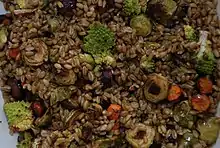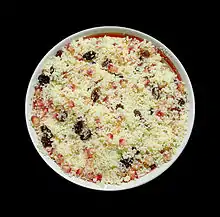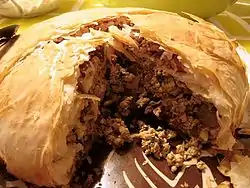This is a list of dishes found in Middle Eastern cuisine, a generalized term collectively referring to the cuisines of the Middle East and the Maghreb region. The Middle East is home to numerous different cultural and ethnic groups. This diversity is also reflected in the many local culinary traditions in choice of ingredients, style of preparation, and cooking techniques.
Middle Eastern dishes
| Name | Image | Country/region | Description |
|---|---|---|---|
| Ahriche | Morocco | Tripe wrapped around sticks and cooked over hot coals | |
| Asida |  |
North Africa | A lump of cooked wheat flour dough, sometimes with butter or honey added[1] |
| Baba ghanoush |  |
Levant | Mashed eggplant with virgin olive oil and various seasonings |
| Baklava | .png.webp) |
Middle East | A layered pastry dessert made of filo pastry, filled with chopped nuts, and sweetened with syrup or honey. |
| Bazeen |  |
Libya | Barley dough served with tomato sauce, eggs, potatoes, and mutton. |
| Bichak | Morocco | A stuffed tricornered appetizer. | |
| Brik |  |
Tunisia | Stuffed pastry. |
| Briouat |  |
Morocco | Sweet puff pastry. |
| Chakhchoukha |  |
Algeria | A stew of lamb, spices, tomatoes, and flatbread. |
| Chermoula |  |
North Africa | A marinade of oil, lemon juice, pickled lemons, herbs, garlic, cumin, and salt, most often used to flavor seafood. |
| Couscous |  |
North Africa | A semolina pasta. |
| Dolma |  |
Middle East | A family of stuffed dishes from Ottoman cuisine that can be served warm or cold. |
| Duqqa |  |
Egypt | A dip of herbs and spices. |
| Falafel |  |
Middle East | deep-fried balls or patty-shaped fritters made from ground chickpeas, broad beans, or both. |
| Fesikh |  |
Egypt | Fermented, salted mullet. |
| Freekeh |  |
Levant | A cereal food made from green wheat that goes through a roasting process in its production. It is an Arab dish that is especially popular in Levantine, Arabian Peninsula, Palestinian and Egyptian cuisine, but also in North African and other neighboring cuisines.[1][2] |
| Ful medames | .jpg.webp) |
Egypt | Mashed fava beans with olive oil, chopped parsley, onion, garlic, and lemon juice. |
| Harira |  |
Algeria and Morocco | A traditional Algerian and Moroccan soup of Maghreb. |
| Hawawshi |  |
Egypt | A traditional Egyptian food very similar to the Middle eastern pizza-like Lahmacun. It is meat minced and spiced with onions and pepper, parsley and sometimes hot peppers and chilies, placed between two circular layers of dough, then baked in the oven. |
| Hummus | .jpg.webp) |
Middle East | A Middle Eastern dip, spread or savory dish made from cooked, mashed chickpeas blended with tahini, lemon juice and garlic. |
| Kashk bademjan |  |
Iran | A staple Iranian dish of kashk and eggplant either, with garnishes of caramelized onions, roasted nuts, herbs and spices. |
| Kebab |  |
Middle East | A wide variety of grilled or barbecued meat dishes often skewered (Shish Kebabs) originating in the Middle East and later on adopted in Turkey, Azerbaijan, Southern Europe, South Asia and Asia Minor, now found worldwide. |
| Kibbeh |  |
Levant | Kibbeh (also kubba or Köfte) is the basis of family of Middle Eastern dishes, and involves a filling of spiced ground meat and onions surrounded by a grain-based outer shell that is fried or baked. |
| Kibbeh nayyeh |  |
Levant | A Levantine mezze that consists of minced raw lamb mixed with fine bulgur and spices. |
| Kushari |  |
Egypt | Made from rice, lentils, chickpeas and macaroni covered with tomato sauce and fried onions. |
| Lablabi |  |
Tunisia | A Tunisian dish based on chick peas in a thin garlic and cumin-flavoured soup, served over small pieces of stale crusty bread. |
| Makroudh |  |
Tunisia and Morocco and Algeria | A pastry often filled with dates or almonds. |
| Matbucha |  |
Morocco | The name of the dish originates from Arabic and means "cooked [salad]". It is served as an appetizer, often as part of a meze. In Israel it is sometimes referred to as "Turkish salad" (Hebrew: סלט טורקי salat turki).[3] |
| Méchoui |  |
North Africa, Cameroon | A whole sheep or a lamb spit roasted on a barbecue. It is popular in North Africa and among the Bamileke people of Cameroon. |
| Merguez |  |
North Africa | A very spicy, red sausage of mutton or beef. |
| Mesfouf |  |
Tunisia | Similar to couscous, with butter added. |
| Mrouzia |  |
Morocco | Sweet and salty tajine with honey, cinnamon and almonds. |
| Msemen | .jpg.webp) |
Maghreb | Traditional pancakes in Maghreb. These pancakes are usually used as an accompaniment to a cup of aromatic morning mint tea or of creamy coffee. Msemen can also be stuffed with vegetables or meat fillings. |
| Mulukhiyah |  |
Egypt | The leaves of the Corchorus species are used as a vegetable in Middle Eastern, East African, North African, and South Asian cuisine. Mulukhiyyah is rather bitter, and when boiled, the resulting liquid is a thick, highly mucilaginous broth; it is often described as "slimy," rather like cooked okra. |
| Pastilla |  |
Algeria and Morocco | A traditional Moroccan dish, an elaborate meat pie traditionally made of squab (fledgling pigeons). As squabs are often hard to get, shredded chicken is more often used today; pastilla can also use fish or offal as a filling. |
| Qatayef | Egypt | An Arab dessert commonly served during the month of Ramadan, a sort of sweet dumpling filled with cream or nuts. It is usually prepared using Akkawi cheese as a filling.[4][5] | |
| Sfenj |  |
North Africa | Donuts cooked in oil then soaked in honey or sprinkled with sugar. |
| Shakshouka |  |
Northwest Africa | A dish of eggs poached in a sauce of tomatoes, chili peppers, and onions, often spiced with cumin.[6] It is believed to have a Tunisian origin.[7] |
| Shawarma |  |
Levant | A dish consisting of meat cut into thin slices, stacked in a cone-like shape, and roasted on a slowly-turning vertical rotisserie or spit. |
| Shish taouk |  |
North Africa | Marinated cubes of chicken are skewered and grilled. |
| Tabil | Tunisia | A Tunisian spice mixture consisting of ground coriander seed, caraway seed, garlic powder, and chili powder. The term can also refer to coriander by itself.[8] | |
| Tabbouleh |  |
Levant | A Levantine salad made mostly of finely chopped parsley, with tomatoes, mint, onion, bulgur (soaked, not cooked), and seasoned with olive oil, lemon juice, salt and sweet pepper. |
| Tajine |  |
North Africa | A Maghrebi dish from North Africa, that is named after the special earthenware pot in which it is cooked. A similar dish, known as tavvas, is found in the cuisine of Cyprus. The traditional tajine pot is formed entirely of a heavy clay, which is sometimes painted or glazed. Tajines in Moroccan cuisine are slow-cooked stews braised at low temperatures, resulting in tender meat with aromatic vegetables and sauce. |
| Toum |  |
Levant | A garlic sauce as prepared in Lebanon, the Levant, and Egypt similar to the European aioli. It contains garlic, salt, olive oil or vegetable oil, and lemon juice crushed using a wooden mortar and pestle.[9] There is a variation popular in many villages, such as Zgharta, where mint is added, called "Zeit and Toum".[10] |
| Usban |  |
Libya and Tunisia | A traditional kind of Tunisian sausage, stuffed with a mixture of rice, herbs, lamb, chopped liver and heart.[11][12] This dish is usually served alongside the main meal of rice or couscous, often on special occasions. |
See also
References
- 1 2 Clifford A. Wright. "Did You Know: Food History - Famous Everyday Dishes from the Medieval Arab World". cliffordawright.com. Archived from the original on 4 July 2015. Retrieved 3 July 2015.
- ↑ Anissa Helou, "Freekeh", in Alan Davidson (editor), The Oxford Companion to Food
- ↑ A Taste of Challah: A Comprehensive Guide to Challah and Bread Baking, Tamar Ansh, Feldheim Publishers, 2007, p. 150
- ↑ Sadat, Jehan; Sādāt, Jīhān (February 2002). A Woman of Egypt. ISBN 9780743237086. Retrieved 3 July 2015.
- ↑ Abu-Zahra, Nadia (1999). The Pure and Powerful. ISBN 9780863722691. Retrieved July 3, 2015.
- ↑ Claudia Roden, The new book of Middle Eastern food, p. 168
- ↑ International Inner Wheel Sfax, Nos recettes de tous les jours et jours de fêtes, p. 115
- ↑ Marks, Gil (2010). Encyclopedia of Jewish Food. John Wiley and Sons. p. 572. ISBN 978-0-470-39130-3.
- ↑ "Toum". Allrecipes.com. Retrieved July 3, 2015.
- ↑ Fayed, Saad. "Toum Lebanese Dipping Sauce - Recipe". About.com Food. Retrieved July 3, 2015.
- ↑ Marks, Gil (2010). Encyclopedia of Jewish Food. Hoboken, New Jersey: John Wiley & Sons. p. 1. ISBN 978-0-470-39130-3. Retrieved February 9, 2012.
- ↑ Clifford A. Wright (1999). A Mediterranean Feast. New York, New York: William Morrow & Co. pp. 72–73. ISBN 0-688-15305-4. Retrieved February 9, 2012.
osban sausage.
This article is issued from Wikipedia. The text is licensed under Creative Commons - Attribution - Sharealike. Additional terms may apply for the media files.